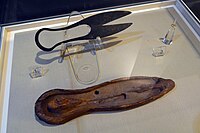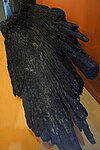Must Farm
 | |
| Location | Whittlesey, Cambridgeshire, England |
|---|---|
| Coordinates | 52°33′18.85″N 0°10′38.35″W / 52.5552361°N 0.1773194°W |
| History | |
| Material | Wood |
| Periods | Bronze Age |
| Site notes | |
| Archaeologists | Cambridge Archaeological Unit |
| Public access | No |
| Website | www |
Must Farm is a Bronze Age archeological site consisting of five houses raised on stilts above a river and built around 950 BC in Cambridgeshire, England.[1] The settlement is exceptionally well preserved because of its sudden destruction by catastrophic fire and subsequent collapse onto oxygen-depleted river silts. [2][3]
The site is on the bed of a now-defunct river in Flag Fen basin,[4] around 2 kilometres (1.2 mi) south of Flag Fen itself.
The site has been described as "Britain's Pompeii" because of its condition[1][5] and was named Best Archaeological Project and Best Archaeological Discovery at the 2012 British Archaeological Awards, and Best Discovery at the 2016 Awards.[6][7] An article describing the settlement won the Antiquity Prize 2020.[2][8]
Early excavations
[edit]Wooden posts were first recognised at the site in 1999, leading to preliminary excavations in 2004 and 2006.[9] Early finds at the site include a rapier and a sword in 1969. Between 2011 and 2012, eight Bronze Age log boats were discovered.[4] The boats were found in a small freshwater palaeochannel and were preserved because of waterlogging.[10]
Radiocarbon dating has indicated that the ages of these boats spanned a period of about 1,000 years, with the earliest examples dating to around 1750–1650 BCE.[11] Some of the boats may have been deliberately sunk.[12] They are now preserved at Flag Fen and are available to view on guided tours.[13]
Bronze Age woven wooden fish traps and wattle-hurdle fish weirs were found in the same channel, together with metalwork including swords and spears.[10]
2015/2016 excavation
[edit]

In September 2015,[10] the University of Cambridge's Cambridge Archaeological Unit began a dig, eventually covering 1,100 square metres (1,300 sq yd),[4] the details of which were publicly disclosed in January 2016.[citation needed]
Historic England funded a £1.1 million project to excavate the site to gain as much knowledge of Bronze Age life in Britain as possible.[5] Archaeologists found two roundhouses, from about 1000–800 BCE, and concluded that they were damaged by fire and that the platform on which they sat then slid into the river, where the fire was extinguished and the buildings and objects within them were preserved in the silt.[5][4][16] About half of the settlement is thought to have been lost to modern-day quarrying.[9]
Objects recovered include pots still containing food, textiles woven from lime tree bark and other plant fibres, sections of wattle walls, and glass beads.[5]
In 2016 a large wooden wheel of about 1 m (3.3 ft) in diameter was uncovered at the site. The specimen, dating from 1,100 to 800 years BCE, represents the most complete and earliest of its type found in Britain. The wheel's hub is also present. A horse's spine found nearby suggests the wheel may have been part of a horse-drawn cart. The find "expands our understanding of late Bronze Age technology", said Duncan Wilson, chief executive of Historic England, which was co-funding the project.[17] As of August 2016[update], the archaeology had been removed and the site reburied to be left sealed.[18]
In 2019 researchers at Cambridge and Bristol universities revealed the results of a study of human and dog coprolites found at the site. They discovered the presence of fish tapeworms, echinostoma worms, capillaria worms and giant kidney worms. The research shows the earliest evidence of human infection by these parasites in Britain.[19][20]
The dig was the subject of a BBC Television documentary, Britain's Pompeii: A Village Lost in Time, first broadcast on BBC Four on 2 August 2016.[21] The excavation became known for its extensive digital outreach.[22]
Gallery of finds
[edit]These artefacts from Must Farm were photographed at Peterborough Museum in July 2017:
-
A pair of shears and its wooden box
-
Fish bones and scales
-
Remains of an eel trap
-
Remains of a boat
-
Iron and Bronze Age swords
-
A dagger, a ring and tips of swords
-
Axe heads
-
A storage vessel
Bibliography
[edit]- Knight, M., Ballantyne, R., Brudenell, M., Cooper, A., Gibson, D., & Robinson Zeki, I. (2024). Must Farm pile-dwelling settlement: Volume 1. Landscape, architecture and occupation. McDonald Institute for Archaeological Research.[23]
References
[edit]- ^ a b Lidz, Franz (19 March 2024). "This Was Village Life in Britain 3,000 Years Ago". The New York Times. Retrieved 19 March 2024.
The superbly preserved remains of a Bronze Age settlement offer a glimpse of a "colorful, rich, varied" domestic life circa 850 B.C.
- ^ a b Knight, Mark; Ballantyne, Rachel; Robinson Zeki, Iona; Gibson, David (12 June 2019). "The Must Farm pile-dwelling settlement". Antiquity. 93 (369): 645–663. doi:10.15184/aqy.2019.38.
- ^ "Post-Ex Diary 13: The Must Farm Pile-Dwelling Settlement Open Access Antiquity Article | Must Farm".
- ^ a b c d "Bronze Age Homes Unearthed in East Anglia". Historic England. 12 January 2016. Retrieved 12 January 2016.
- ^ a b c d "Bronze Age houses uncovered in Cambridgeshire are Britain's 'Pompeii'". BBC Online. 12 January 2016. Retrieved 12 January 2016.
- ^ "British Archaeological Awards 2012". Council for British Archaeology. 9 July 2012. Retrieved 14 July 2016.
- ^ "'Britain's Pompeii' was 'Bronze Age new build' site". BBC News. 14 July 2016. Retrieved 14 July 2016.
- ^ "Prize Winners". Antiquity. 2020. Retrieved 4 June 2020.
- ^ a b "About". mustfarm.com. Retrieved 12 January 2016.
- ^ a b c "Must Farm". Retrieved 12 January 2016.
- ^ "BBC News Cambridgeshire Flag Fen Bronze Age boats older than was first thought". 8 September 2013. Retrieved 8 September 2013.
- ^ Kennedy, Maev (4 June 2013). "News Science Archaeology Eight bronze age boats surface at Fens creek in record find". The Guardian. London. Retrieved 5 June 2013.
- ^ "Must Farm boats". Vivacity. Archived from the original on 9 February 2018. Retrieved 9 February 2018.
- ^ "Latest archaeological finds at Must Farm provide a vivid picture of everyday life in the Bronze Age". Retrieved 17 August 2016.
- ^ "Site Diary 21: A Tour of the Excavation: Part One". Must Farm. Retrieved 25 August 2016.
- ^ Must Farm Project [@MustFarm] (13 January 2016). "...we have two buildings so far..." (Tweet). Retrieved 13 January 2016 – via Twitter.
- ^ "Bronze Age wheel at 'British Pompeii' Must Farm an 'unprecedented find'". BBC News. Retrieved 18 February 2016.
- ^ Mustfarm FAQs at mustfarm.com
- ^ Sample, Ian (16 August 2019). "Bronze age meals in the marshes – seasoned with parasitic worms". The Guardian. ISSN 0261-3077. Retrieved 17 August 2019.
- ^ "'Earliest' tapeworms found at 'Britain's Pompeii'". BBC News. 16 August 2019. Retrieved 17 August 2019.
- ^ "Britain's Pompeii: A Village Lost in Time". BBC Television. 26 December 2016. Retrieved 26 December 2016.
- ^ Wakefield, Christopher (5 October 2020). "Digital Public Archaeology at Must Farm: A Critical Assessment of Social Media Use for Archaeological Engagement". Internet Archaeology (55). doi:10.11141/ia.55.9. ISSN 1363-5387.
- ^ Knight, Mark; Ballantyne, Rachel; Brudenell, Matthew; Cooper, Anwen; Gibson, David; Robinson Zeki, Iona (5 March 2024). Must Farm pile-dwelling settlement: Volume 1. Landscape, architecture and occupation. McDonald Institute for Archaeological Research. doi:10.17863/cam.106697. ISBN 978-1-913344-15-3.









